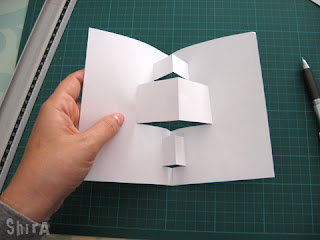INSTRUCTIONS:
1. Select the paper that you intend to use on the inside of the card and fold it in half below used a scrap of printer paper for this demonstration, but a card stock or heavy-weight paper will provide you with a sturdier mechanism.
2. On the outside of the folded card, draw one or more rectangles of any size, making sure one side of the rectangle matches the center fold. Make sure the length of the cut you are planning (which dictates the length (=depth) of the box) is shorter than half of the card’s depth, or else the box might peek out of the card.
3. For each rectangle, cut along those sides which are perpendicular to the fold (marked with a solid line). Score the top line, DO NOT cut along the top (marked with a dash line). Open the card and push the boxes gently inwards, reversing their “natural” direction. Pinch the popping corner of each box to set the fold into its new direction.
1. Select the paper that you intend to use on the inside of the card and fold it in half below used a scrap of printer paper for this demonstration, but a card stock or heavy-weight paper will provide you with a sturdier mechanism.
2. On the outside of the folded card, draw one or more rectangles of any size, making sure one side of the rectangle matches the center fold. Make sure the length of the cut you are planning (which dictates the length (=depth) of the box) is shorter than half of the card’s depth, or else the box might peek out of the card.
4. Carefully close the card, making sure to flatten the creases you initially scored.
5. And there you have it! Note that the box is symmetrical- the height and depth are even. You can use the boxes as a base for glued-on decorative images, or even use them as the main popping element of the card.
Here is the final output








Comments
Post a Comment